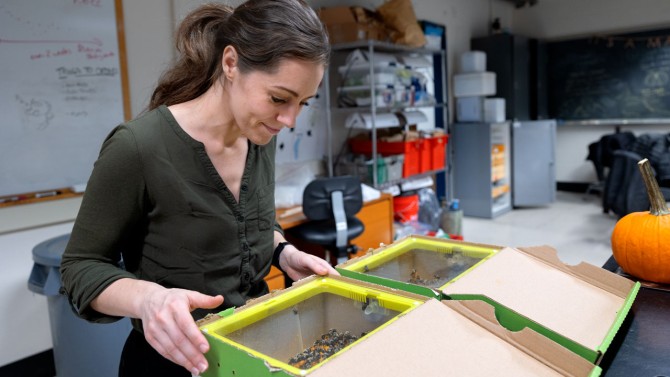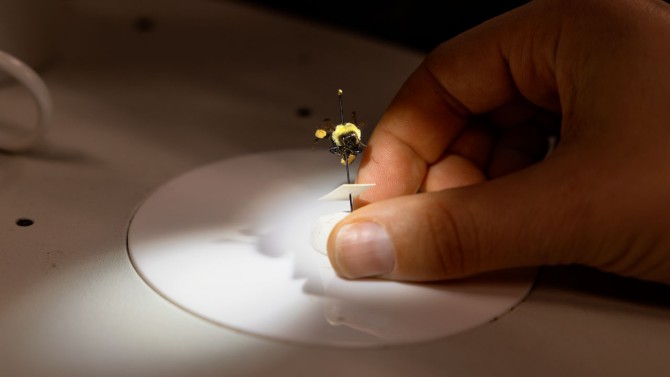Wild bumblebee queens lured and killed in commercial hives
Wild bumblebee queens lured and killed in commercial hives
By Krishna Ramanujan, Cornell Chronicle
In the course of experiments to test how well commercial bumblebees pollinate early spring crops, researchers made a surprising discovery: dead wild bumblebee queens in the hives, an average of 10 per nest box.
A new study finds that nest boxes of commercial eastern common bumblebees (Bombus impatiens) lead to the deaths of wild queens who are attracted to the brightly colored hives.
The boxes draw wild B. impatiens queens (and those of other species) engaged in usurpation, a natural behavior in which a queen who has yet to establish her own nest takes over another queen’s nest for a potential advantage. These usurping wild queens are killed by workers upon entry, as commercial hives have many more workers than natural nests.
Though more research is needed, the loss of wild queens in nest boxes may be contributing to an overall decline in local B. impatiens populations around these farms.
An existing technology called an excluder, which narrows the nest box doorway, was 100% effective at keeping the resident queen in and usurpers out, according to the study.
“Every one of those queens that is killed will now not found her own nest somewhere else on that farm, which would then contribute worker bees later in the season to pollinate those crops,” said Heather Grab, senior lecturer in the School of Integrative Plant Science in the College of Agriculture and Life Sciences (CALS).
Grab is senior author of the study, “Commercial Bombus impatiens Colonies Function as Ecological Traps for Wild Queens,” published Feb. 6 in the Journal of Applied Ecology. Olivia Miller ‘21, who worked on this research as part of her undergraduate thesis, is the paper’s first author.
The finding potentially adds to the list of human practices that contribute to the decline of wild bee populations. While wild eastern bumblebee populations are not a species of conservation concern, the researchers did find dead queens of other species, such as the declining Bombus perplexus (called the confusing bumblebee), inside the commercial hives.
The study initially began as a separate inquiry, to test whether commercial bumblebees were more optimal than honeybees for some crops, such as early season strawberries, when weather is cool and honeybees are less active, and later season crops, such as tomatoes, where honeybees are ineffective pollinators.
Along with finding dead queens, the study’s authors also learned that when commercial colonies were added to farms earlier in the year, overall fewer bumblebees made fewer visits to later season crops such as tomatoes. This was the opposite of what they expected.
After probing the literature, Miller hypothesized that the dead queens in commercial hives could be due to poorly understood usurping behavior. In addition, the bright colors and smells of the nest boxes may serve as hyper-attractive cues to nest-searching queens.
To test the hypothesis, Miller, Grab and colleagues placed commercial bumblebee colonies in early spring on apple orchards in eight sites around the Finger Lakes area of New York. Commercial colonies were set up side by side, half of them with queen excluders in the open doorways, and half with no excluder. They also marked each hive’s original queens. The nests were then checked every few days over a two-week period. In nests without excluders, many usurping dead queens, were found; one site had 19 dead queens in it.
“If you are a commercial grower, and you are wanting to manage bumblebees, especially if you are bringing those in early in the season, you may actually be reducing your overall pollination services by investing in these commercial bumblebee colonies, unless you are taking some risk-mitigation strategies like putting in a queen excluder,” Grab said.
Katja Poveda, associate professor of entomology in CALS, is a senior co-author of the paper.
The study was funded by the United States Department of Agriculture and the Cornell University Agricultural Experiment Station.
Media Contact
Get Cornell news delivered right to your inbox.
Subscribe


